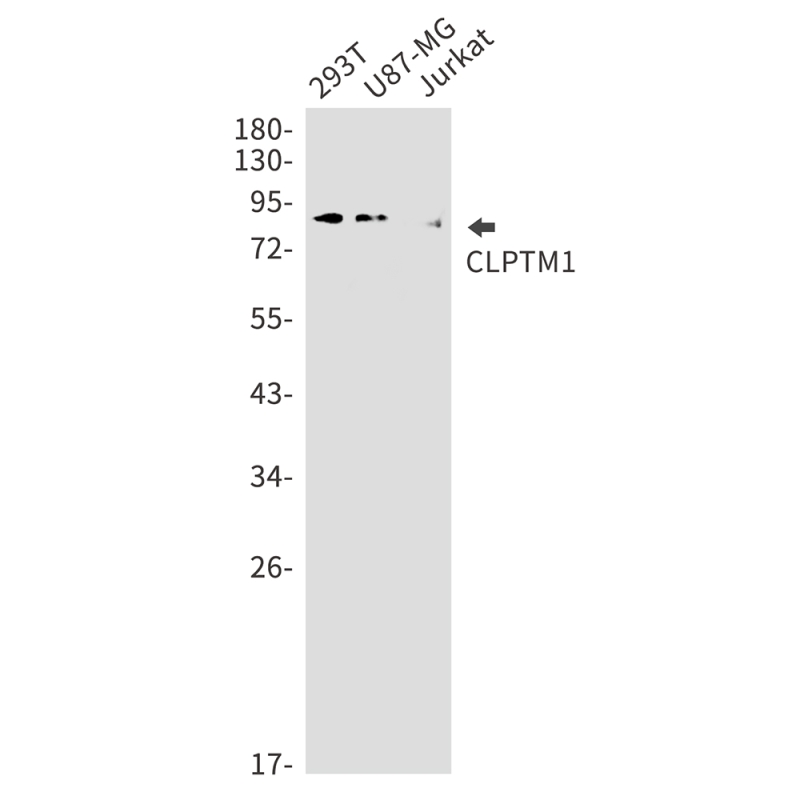
| WB | 咨询技术 | Human,Mouse,Rat |
| IF | 1/20 | Human,Mouse,Rat |
| IHC | 咨询技术 | Human,Mouse,Rat |
| ICC | 技术咨询 | Human,Mouse,Rat |
| FCM | 咨询技术 | Human,Mouse,Rat |
| Elisa | 咨询技术 | Human,Mouse,Rat |
| Aliases | Cleft lip and palate transmembrane protein 1 |
| Entrez GeneID | 1209 |
| WB Predicted band size | Calculated MW: 76 kDa; Observed MW: 90 kDa |
| Host/Isotype | Rabbit IgG |
| Antibody Type | Primary antibody |
| Storage | Store at 4°C short term. Aliquot and store at -20°C long term. Avoid freeze/thaw cycles. |
| Species Reactivity | Human |
| Immunogen | A synthetic peptide of human CLPTM1 |
| Formulation | Purified antibody in TBS with 0.05% sodium azide,0.05%BSA and 50% glycerol. |
+ +
以下是关于CLPTM1抗体的3篇示例文献(内容基于学术研究常见方向,建议通过学术数据库核实最新成果):
1. **文献名称**:*CLPTM1L promotes cisplatin resistance in lung cancer through regulation of autophagy*
**作者**:Zhang Y, et al.
**摘要**:该研究利用CLPTM1抗体检测肺癌细胞中CLPTM1L蛋白表达,发现其通过激活自噬通路增强癌细胞对顺铂的耐药性,沉默CLPTM1L可逆转耐药表型。
2. **文献名称**:*CLPTM1 modulates EGFR trafficking and signaling in head and neck cancer*
**作者**:Wang H, et al.
**摘要**:研究采用CLPTM1抗体进行免疫共沉淀和免疫荧光实验,揭示CLPTM1通过与EGFR相互作用调控其内吞和下游MAPK信号,影响肿瘤细胞增殖。
3. **文献名称**:*High CLPTM1 expression correlates with poor prognosis in ovarian cancer*
**作者**:Liu X, et al.
**摘要**:通过免疫组化(使用CLPTM1抗体)分析卵巢癌组织,发现CLPTM1高表达与患者总生存期缩短显著相关,提示其作为预后生物标志物的潜力。
**建议**:可通过PubMed或Google Scholar搜索关键词“CLPTM1 antibody”、“CLPTM1L function”获取最新研究。
The CLPTM1 (Cleft Lip and Palate Transmembrane Protein 1) antibody is a tool used to study the CLPTM1 protein, a conserved transmembrane protein implicated in diverse cellular processes. Initially linked to craniofacial development due to its association with cleft lip/palate, CLPTM1 is now recognized for broader roles, including vesicular trafficking, autophagy, and apoptosis regulation. It localizes to endoplasmic reticulum (ER) and Golgi membranes, influencing intracellular transport and organelle dynamics.
In cancer research, CLPTM1 is studied for its oncogenic potential. Overexpression correlates with chemoresistance in cancers like ovarian and lung cancer, possibly by modulating glycosylation of survival factors (e.g., Bcl-xL) or interacting with pathways like PI3K/AKT. Conversely, in neurodegenerative contexts, CLPTM1 may regulate synaptic plasticity and neuronal survival, with altered expression observed in Alzheimer’s disease models.
CLPTM1 antibodies (polyclonal/monoclonal) enable detection of endogenous CLPTM1 in assays such as Western blot, immunofluorescence, and immunohistochemistry. They aid in exploring its tissue distribution, subcellular localization, and interaction partners. Researchers also use these antibodies to dissect CLPTM1’s dual roles in promoting cell survival (in cancer) or apoptosis (in neurotoxicity), highlighting its context-dependent functions. Species reactivity typically includes human, mouse, and rat, supporting translational studies.
×